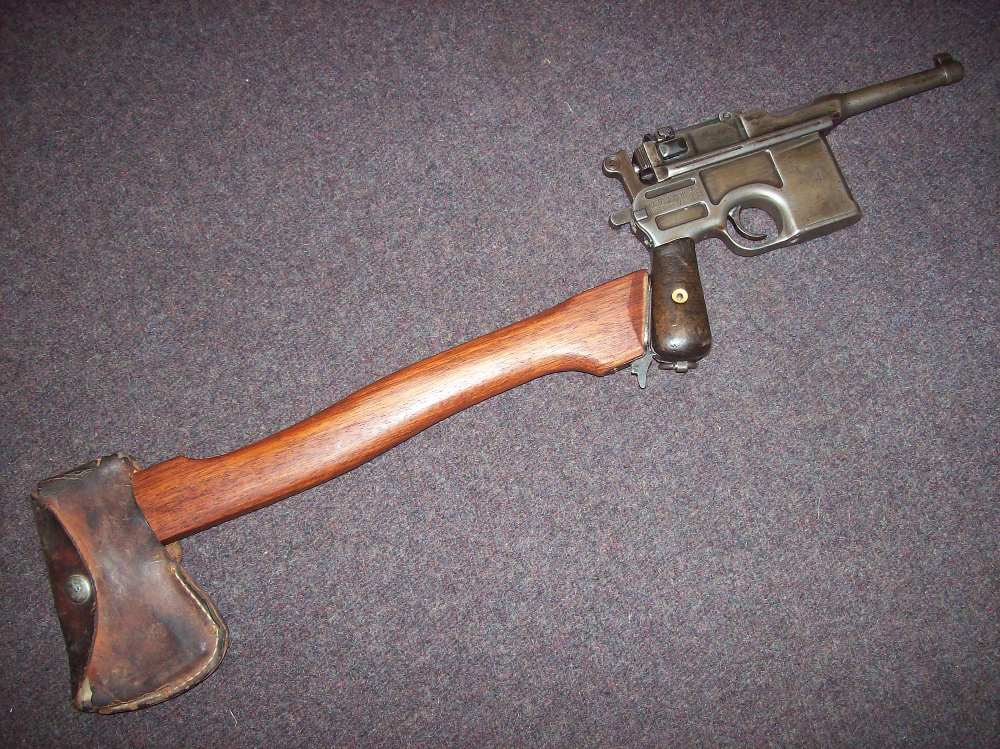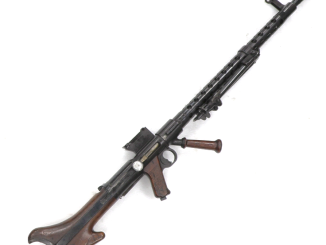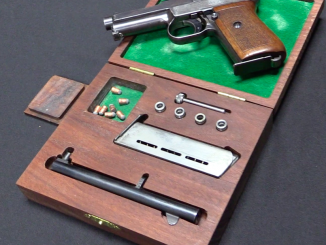There is an old gun shop tale that Argentine Ballester-Molina pistols were made form the salvaged armor plate of the pocket battleship Admiral Graf Spee. The Graf Spee was scuttled in the Rio de la Plata estuary in December 1939, only a few miles from the HAFDASA factory in Buenos Aires, and Argentina did not have the domestic steel reserves to make enough pistols…
See Michael Parker’s full article on this, including the exact results of his metallurgical analysis.




Except what they failed to take into account was that the armor plate after extended exposure to salt water had to be melted down as scrap and during that process it was mixed with other iron and scrap steel and alloyed to the specifications given by the manufacturer.
When I lived in Argentina my landlady was the daughter of one of the men in the local steel industry and she talked about (with great pride) how argentine steel was some of the best in the world at the time etc etc (prior time WW II Argentina was in a path to becoming a world power then Peron happened).
So good in fact that they cut up and used german armor as feed stock.
Go with the comment that there was more than one type of scrap steel in the melt. Some of it was probably Graf Spee, plenty of other scrap as well. Base steel ended up being watered down.
Reasoning is the cost of moving the scrap from River Platte to Britain is pointless when you can sell it to a local source. Some of the steel definitely went to England, but most probably ended up in Argentina with the pistols being only one place it was used.
Doing the back of the cocktail napkin math, considering what they got the wreck for, the Brits probably made a decent buck out of it. Not the first time I’ve heard of an undercover op turning out to be a successful business as well.
1. Given the disparity of armament, it’s not really correct to say that the British had it handed to them in the battle of the River Plate.
2. The German battleship Tirpitz, sunk in Norway, contributed a number of big steel plates to the Norwegian highway department for temporary road surfaces during repairs. Some may still be in use.
3. And if you want a Tirpitz steel knife, or just some pieces, Boker will fix you up- https://www.boker.de/en/search?sSearch=tirpitz
Yes, the Graf Spee greatly outgunned the British cruisers, with six 11 inch and eight 6 inch guns as opposed to the six 8 inch on the Exeter and eight six inch guns on the Ajax and Achilles (which was a New Zealand ship). These British ships were actually much smaller than “standard” treaty cruisers of the era as they were sized to get the maximum number of cruisers out of the treaty tonnage limits in order to be able to cover more of the ocean while doing their job of commerce protection.
The Graf Spee was specifically designed to outgun standard treaty cruisers and outrun battleships. Since Germany was not part of the naval treaties limiting what the major naval powers could build they weren’t bound by the same design criteria and so were free to “think outside the box”. Germany’s smaller battleships also used 11 inch guns, but more of them.
On paper, the decision of the British commander to fight it out with the Graf Spee was suicidal. However, he used clever positioning of his ships to make the gunnery problems more difficult for the Graf Spee while they pecked away at it. In the end however it was British intelligence’s fooling the Germans into thinking there were major British naval units just about to arrive which convinced the Germans to scuttle.
Suicidal, English, to-may-to, to-mah-to.
“(…)Tirpitz steel knife(…)”
This reminded me about Kinmen knife: https://en.wikipedia.org/wiki/Kinmen_knife
they were made from metal salvaged from shells which were used by PRC to shell China in 1958. See https://en.wikipedia.org/wiki/Second_Taiwan_Strait_Crisis (conflict known in Russian as Война пушек that is War of cannons)
Apparently the Communists didn’t expect the Kinmen locals to start salvaging the remnants of their projectiles. Kinmen Island is also known for exporting very strong Kinmen Kaoliang liquor (up to 63% pure alcohol). Due to wartime restrictions on commercial building development, the island is now a nice tourist destination. It also appears that paintball events are held in old battle sites. Please don’t shoot me for this.
Never let facts stand in the way of a good story!
This Graf Spee story is really juicy one and when I read about it first time years ago, it lit up my imagination. Half adventure, half tragedy it was not the first case of stranded (and scuttled) German war ship – it happened in Pacific too.
When comes to steel, I do not think the chemical analyses is capable of proving origin of a material. If there were some unique element such as Arsenic or something like that in larger than usual measure – maybe. But steel contains mostly iron and carbon, save for traces of sulphur and phosphor. The alloy steels contain on top of it a couple of percent of nickel and chrome and that is it. Main thing is temper (state of carbon conversion in the mixture) which delivers strength and toughness and that can be done with common medium-carbon steel no matter where it was produced.
Origin of particular steel manufacture is an exciting issue. I am searching (impossible to find on net) where originates steel used by Toyota Canada. My strong suspicion is it comes from Brazil. I’ll find out one day 🙂
I recall one funny steel related story form old country. In early 60s the state owned Skoda automobile works were using Austrian made steel (for its superior draw ability). Since it was undesirable knowledge to general public, undermining the official ideology, the wraps form delivered stacks of sheet were promptly discarded. Oh yes, even steel can be subject of politics.
It’s a matter of pride. However, one has to remember that China killed lots of professional smelters during the “Great Leap Forward” and then epically failed at making steel bridge girders. No surprise that the result of tossing broken bike frames, rusted gun barrels, raw iron ore from different mines, burnt-out airplane piston engines, and even captured American tank hulls into a melting pot guarded by illiterate fools led to a yield of useless over-carbonized pig iron. Yes, this is just the exaggeration of what happened.
You should see Chinese fast train frames manufacturing; it is based on steel fabrication. Those frames see multiple stresses in multiple modes and yet, hurl forward at speed no train in U.S. moves. You have to respect the progress.
To be honest futility of backyard furnace
https://en.wikipedia.org/wiki/Backyard_furnace
was recognized by Party quickly, but it was not shut-down immediately to avoid lessening enthusiasm. Also I suggest to differentiate between PRC in 1958 and PRC after this country rework lead by Deng Xiaoping which started in 1978.
“(…)Yes, this is just the exaggeration of what happened.(…)”
Well, maybe, but anyway that is what should be excepted when political targets are treated as foremost (if not sole) with all economic technical &c considerations marginalized. Sadly Soviet Union did this more than once, see for example Belomorkanal
https://en.wikipedia.org/wiki/White_Sea%E2%80%93Baltic_Canal
which was success solely on propaganda plane. Any realistic consideration of economic nature would result in decision to not build it in shape in which it was actually build. If you want longer description in English language look at The Ghost of the Executed Engineer: Technology and the Fall of the Soviet Union
In 1945-6 US Gen. Eisenhower discovered that his Soviet opposite number was fond of Coca-Cola. Eisenhower prevailed on a local bottler to make the stuff in clear form, sealed by plain bottle-caps adorned only with a red star. He would present a case to Comrade General every visit, to smooth negotiations. Thus do appearances pave the road in politics and life.
Ah, yes, Zhukov and White Coke. I wonder how much sugar and stimulant he needed for the frontline job…
From the NAVWEAPS site
“1208. Manufacture of Krupp cemented armor.-Carbon being the principal hardening element, the natural tendency is to carry the carbon content as high as possible. The higher the carbon, however, the more difficult becomes manufacture, tears appear in the forging, fibering the plate becomes more difficult, and the plate becomes brittle, making it liable to cracking and excessive spalling (detaching of surface fragments) on ballistic test. The addition of nickel increases the toughness of the plate, and permits it, when properly treated, to be fibered; while the chromium adds hardness without the extreme brittleness which would accompany this hardness if produced solely by carbon. The chromium also renders the steel particularly sensitive to heat treatment and thus facilitates the final decremental water hardening.
A typical chemical analysis of a modern Krupp cemented plate is as follows:
Carbon .35
Nickel 3.90
Chrome 2.00
Manganese .35
Silicon .07
Phosphorus .025
Sulphur .020
In this connection it is interesting to note that when K. C. armor was first introduced into America, the plates ran about .27 per cent carbon, 3.75 per cent nickel, and 1.75 per cent chromium. The increase in carbon and chromium and the increased resistance of modern K. C. armor is indicative of the improvement in metallurgical skill.”
As has been pointed out, any German armor steel would be mixed in with other scrap, diluting the these figures and they may have been removed from the mixture because they caused undesirable effects in the final product. Also, warships were not constructed out of just armor plate, but most of their structure was mild steel, so that would also go into the mix
For more than you could possibly want to know about the subject of naval armor
see NAVWEAPS resident technical guru’s magnum opus
“Table of Metallurgical Properties of Naval Armor and Construction Materials”
http://www.navweaps.com/index_nathan/metalprpsept2009.php
part of an incredible resource “Nathan Okun Naval Gun and Armor Data Resource”
http://www.navweaps.com/index_nathan/index_nathan.php
Iron units for a Steel plant are just iron units, whether it comes from horseshoes, tin cans or battleships. All these other alloying units such as nickel, Chrome Manganese Vanadium etc can be watered down or even removed using the right slags. What cannot be usually removed is copper. I do not know what the composition of the Graff Spee armour was, but if it was copper bearing, that should show up as a substantial trace element if the armour was used in the Ballister Molina.
Copper in steel? Hmm, all right. I know that Copper is used as alloy in Super dural.
Strength for steel for part can be gained by rolling/ homogenizing fibre and in some instances by heat-treating entire sheets. Science is high, but many things were done in past and worked well. I think the break point was Martin-Bessemer process. https://en.wikipedia.org/wiki/Bessemer_process
All the Armco Barrier steel is copper bearing. It adds toughness to otherwise hard and brittle high strength steels. So your armour plate will deform under shell impact and stop the warhead detonating inside the superstructure.
interesting to say the least
G Gordon Liddy wrote a thriller many years ago called The Monkey Handlers, if I recall. In it, one of the characters had a BM .45 that was said to be made with Graf Spee steel. All the characters gathered round it as it was racked, because it apparently had a special RING as it went into battery.
Needless to say, even in my teens, I was suspicious…after all, G Gordon had written this…
There really is an unfounded myth around these guns and th ship .
The Admiral Graf Spee it was sunk in the port of Montevideo, Uruguay, immediately
It was immediately reviewed by MI6 and the Royal Navy ; the MI6’s base in South America was … Montevideo and a the mission chief was a Commander of the Royal Navy .
The ship was NEVER scrapped unless they took instruments and photographed in January 1940 , and there is no documentation of it or photographs that happened, being a myth or a myth that an Argentine participation .
It was bought at the time by the Uruguayan state which is the current owner of the wreck, the current side scan sonar images confirm that it is seated at the bottom of the river without its command tower which is on port .
a few years ago they wanted to refloat it (the cost was 30 million dollars) but the existence of unexploded torpedo heads makes that company unfeasible.
And, of course, we don’t know what batch of Ballester Molinas provided Parker’s sample. Unless of course he documents that in his article. [cheating by actually READING] Parker does say he used a Ballester from the right serial range. But the armor composition he sites is TANK armor, not naval.
Good page for those who are interested in steel and malleable materials in general http://www.matweb.com/
I never heard mentioned the part that the Graf Spee was under orders not to fight British ships. In any prior account of this ship or of this battle, ships of this class were not armored to engage in gun battles. The German captain had disobeyed orders when he decided to engage the British. My reading of this has been for the last fifty years been very consistent about this. Also Ian,the Germans didn’t have radar on their ships at that time. What they did have were wonderful German optics and calculators to support their gunnery. It was the British who utilized radar gunnery against the Kriegsmarine in Norway, to great advantage.
The Germans did have radar on their ships. The Graf Spee was equipped with an early set. I just looked it up.
She carried an early model Seetakt https://en.wikipedia.org/wiki/Seetakt
“These early systems proved problematic, and a new version using improved electronics at 60 cm wavelength (500 MHz) was introduced. Four units were ordered and installed on the Königsberg, Admiral Graf Spee and two large torpedo boats (which in German service were the size of small destroyers). The Admiral Graf Spee used this unit successfully against shipping in the Atlantic. In Dec. 1939, after heavy fighting during the Battle of the River Plate, the Admiral Graf Spee was severely damaged and the captain scuttled the ship in the neutral harbor off Montevideo, Uruguay. The ship sank in shallow water such that its radar antenna was still visible”
The reason the British bought the Graf Spee was to get at her radar – they apparently learned a lot
Copper contamination of steel is a problem, the major source is recycled automobiles.
If any steel from the ship was used it hung around for a while. The ship was scuttled at the end of 1939, production of the British contract BM’s did not start until 1943 and ran thru into 1944. Records in the National Achieves in London show that the company was lacking in sufficient machinery to make the pistols in quantity. In SOE files the British order is reported as being 12,000 and Cabinet Office documents refer to 15,000 with the prospect of another order of 35,000 if things went well with the first 15,000, which they did not.
In the end only 8,000 were delivered.
Regards
AlanD
Sydney
Tangentially, several radiation labs in the US have test chambers lined with armor from US Navy battleships. The armor plate was made before any atomic bomb detonations so it has no radioactive particles and makes excellent shielding for sensitive detection gear.
Pieces of the scuttled fleet at Scapa Flow are also used for detectors.
I think the myth of the pistols made from the Graf Spee grew simply from the fact that the HAFDASA factory was in Buenos Aires and the wreck is in the Rio Plata. Someone added these two facts together and you get a nice story. Probabaly to sell these weird not quite M1911 pistols from Argentina.